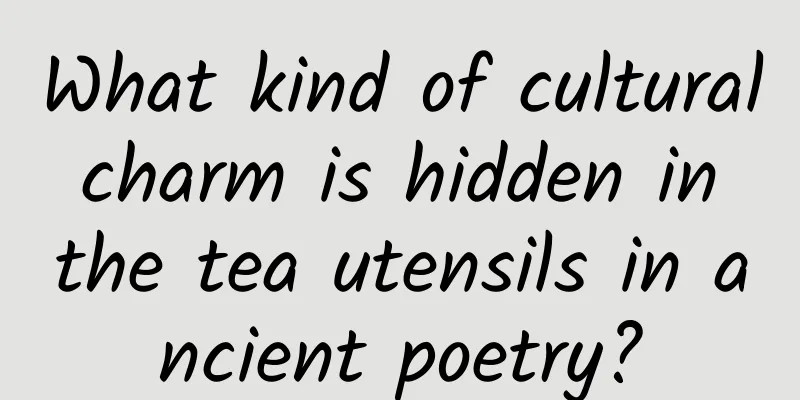What kind of cultural charm is hidden in the tea utensils in ancient poetry?

|
Literati and tea is a topic that can be discussed from many angles. After all, they have been together for thousands of years and have created countless interesting stories. What do teaware and tea sets in tea poems look like? What kind of teaware do well-known poets such as Su Dongpo and Lu You like to use? Let's start from tea poems, move on to teaware, and move on to the subtleties of tea culture. Sencha Bamboo Smoke "The scent lingers on the Zen couch, and the smoke from brewing tea grows in the bamboo forest." --Yu Chou, Song Dynasty, "Leaving the County and Traveling to Heshan" For a long period of history, ancient people boiled tea and drank it - poets often called it "boiled tea". The utensils used for boiling or boiling tea include tea pots, tea kettles, tea stirrers, etc. As indispensable tea-making utensils, they often appear in poets’ writings, such as Jiaoran’s “throwing tea into the pot makes foam, and the bowl gathers flowers”; Wu Rong’s “the smoke is cold and the tea pot is still, the waves are fragrant and the orchid boats are flying”; Yuan Zhen’s “the pot is simmering yellow buds, and the bowl turns into dusty flowers”. Wang Wei, a famous Tang Dynasty poet, also loved tea. There was nothing else in his study, “only a tea pot, a medicine mortar, a scripture desk, and a rope bed”. The tea kettle is one of the utensils for brewing tea, and it has been mentioned many times in Tang and Song Dynasty poems and essays. For example, the tea kettle of Gongxian Kiln in the Tang Dynasty is glazed with tea leaves on the outside and white glaze on the inside. The shape of the kettle imitates the gold and silver wares of the Tang Dynasty. Such gold and silver wares are found in the cultural relics unearthed from the Hejiacun cellar in Shaanxi. The "Gongxian Kiln" located in Gongxian County, Henan Province, is an important kiln in the Tang Dynasty. It fired a wide variety of products. In addition to white glaze, black glaze, and yellow glaze wares, there are also famous tri-color wares. The uniqueness of this tea kettle lies in the combination of tea leaves glaze on the outside and white glaze on the inside, which is also rare among similar wares in Gongxian Kiln. Tea Bamboo Shade "The water from Shanghe Well is as sweet as honey, and tea is brewed under the bamboos at Pengshan Mountain." - Chao Buzhi, Song Dynasty, "Zhilu Lianju" Unlike the Tang Dynasty, people in the Song Dynasty did not boil tea leaves directly in a pot, cauldron, pan or kettle. Instead, they put the tea leaves in a teacup, boiled water in a tea bottle, stirred the tea leaves with a teaspoon or tea whisk, and finally drank the tea in a teacup with a tea tray. Therefore, tea bottles, teaspoons, teacups, etc. were important utensils in tea drinking activities in the Song Dynasty. The elegant life of people in Song Dynasty was influenced by tea and bamboo, such as Su Dongpo's "I am alone under the bamboo with tea smoke", Ao Taosun's "There is tea smoke among bamboos", Yao Mian's "There are bamboos near the tea stove"; Lu You's "The tea stove is set up in the shady bamboo grove" and "I drink tea with monks in the bamboo courtyard", etc. Changsha Kiln in the Tang Dynasty produced a large number of underglaze painted porcelain. It broke through the single glaze color of celadon, enriched the decorative technology of Tang Dynasty porcelain, and pioneered underglaze colored porcelain. In the early days of Changsha Kiln, there were single brown spots, which gradually developed into brown-green spots. The decorative content developed from spot patterns to flower, bird, animal patterns, or poems. Its decorative technique is to use a brush to paint patterns on the raw body with colored materials, and then cover a layer of transparent glaze and burn it at high temperature. For example, the Changsha Kiln celadon glaze brown color cloud pattern porcelain bowl, the body is covered with celadon glaze inside and outside, the outer wall of the vessel is decorated with four brown spots, and the glaze on the outer wall does not reach the bottom. The center of the bowl is outlined with underglaze brown color to outline the cloud pattern, and the brown color lines are painted with underglaze green color, and the overall pattern lines are smooth. Tea was knocked across the bamboo "At noon, I was alone and there was no sound. A mountain boy was knocking on the tea mortar through the bamboo." - Liu Zongyuan, Tang Dynasty, "Occasional Writing in Summer Day" After brewing the tea given by a friend, Zhu Kuntian, a Qing Dynasty poet, wrote with some sarcasm, "I laugh at the people of the Tang and Song dynasties, who valued round cakes. They had to rely on stone mortars to grind and beat with silver stems." The poet seemed to be mocking the tediousness of grinding and beating round cakes of tea. The "stone mortar" was one of the grinders used by the people of the Tang and Song dynasties. The other two grinders that were popular at one time were tea rollers and tea grinders. Although the way of drinking powdered tea in the Tang and Song dynasties was indeed not as simple as the way of drinking leaf tea in the Ming and Qing dynasties, judging from the poetry and prose of the Tang and Song dynasties, the poets and writers found it interesting to listen to the crisp sound of knocking on the tea mortar and watch the tea powder falling like green dust or snowflakes. Teaware carries the message The metaphysical is called Tao, and the physical is called Qi. Tao is inseparable from Qi, and Qi carries Tao. Lu Yu called the utensils for brewing and drinking tea Qi, which has given these tea utensils based on daily life a spiritual and cultural connotation that transcends daily life. So far, tea utensils are no longer just daily utensils that simply satisfy hunger and thirst, but also contain a deeper connotation of "Tao". Because teaware carries and covers many factors such as culture, realm, aesthetics and spirit, Lu Yu emphasized that in formal elegant gatherings and tea parties, we should pay attention to the practicality, beauty, harmony and perfection of teaware. If one of the twenty-four utensils is missing, the tea will be ruined. In Lu Yu's vision and spiritual world, whether the teaware in a tea ceremony is complete and perfect is related to the etiquette and rise and fall of the tea ceremony. From this point of view, the importance of teaware, its rich cultural connotation and spiritual character are waiting for us to slowly "taste". Li Yiping |
>>: Are autonomous vehicles generally more reliable than human drivers? | Technology Weekly
Recommend
Mr. Xin and Mr. Ling's "Healthy Meta-Universe"
This is the 3538th article of Da Yi Xiao Hu Mr. X...
How does BuzzFeed, the American version of Toutiao, achieve viral communication?
At the beginning of the year, Bytedance's XX ...
What is the secret behind TikTok’s explosive user growth?
Think first: How do you measure user growth ? Wha...
Insights | The secret to staying happy: Don’t get upset or argue
Famous Artists Gallery | Henri Matisse, a famous ...
Wired: Smartwatches are not the future of wearable devices
Wired writer Mat Honan believes that wearable dev...
BMW 5 Series M Performance Edition official pictures released, debut early next year
Recently, BMW released a set of official pictures...
Does increasing the volume of information flow advertising really require piling up a large number of accounts and plans?
In the information flow advertising industry, who...
Tencent Designer: Help you fully grasp the key points of search design from 4 aspects
In a content-based APP, the search function can b...
Google's "robot dog" enters service and is tested by the Marine Corps
Google's Legged Squad Support System (LS3) rob...
Misconception! 5 common misunderstandings about information flow advertising image materials, with 4 guidelines + 2 cases attached!
Introduction: This article lists five major color...
What? Cockroaches can also make oil? Cooking oil!
What? Cockroaches can also make oil? Cooking oil?...
What health issues should you pay attention to when riding shared bicycles?
As a product of the Internet O2O (online to offli...
3 factors that affect product promotion and conversion (Part 2)
Many adjustments seem simple, but the leverage ef...
Chinese Academy of Sciences: White Paper on the Development of Artificial Intelligence in 2019
The Key Laboratory of Big Data Mining and Knowled...
ASUS ZenFone 5 first review
ASUS ZenFone 5 adopts an all-in-one straight-panel...









